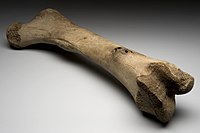
Photo from wikipedia
Abstract Background Osseous‐associated cervical spondylomyelopathy (OA‐CSM) is a complex disorder with limited long‐term survival. The longitudinal progression is currently unknown. Objective To describe changes on magnetic resonance imaging (MRI) over… Click to show full abstract
Abstract Background Osseous‐associated cervical spondylomyelopathy (OA‐CSM) is a complex disorder with limited long‐term survival. The longitudinal progression is currently unknown. Objective To describe changes on magnetic resonance imaging (MRI) over a 2‐year minimum period. We hypothesized that spinal lesions would progress in the majority of dogs. Animals Eleven dogs previously diagnosed with OA‐CSM were prospectively studied. Nine dogs were treated medically, whereas 2 were treated surgically. Methods Clinical and MRI follow‐up were performed with a median time between MRI studies of 30 months (range, 24‐54). Morphologic assessment evaluated vertebral canal stenosis, spinal cord compression, foraminal stenosis, and articular processes, among other variables. Morphometric assessment included vertebral canal area, spinal cord area, area of the articular processes, and foraminal height. Results On follow‐up MRI, the most affected site at the initial examination in medically treated dogs had progressed in 4 of 9 dogs, improved in 4, and was unchanged in 3. Clinically, all dogs except 2 medically treated dogs were unchanged to improve at follow‐up. Initially, 50 of 60 (83.3%) intervertebral spaces had vertebral canal stenosis, whereas in the follow‐up MRI 82.3% did. Of the sites with stenosis, 45.7% were unchanged, 18.6% improved, and 38.9% worsened. Morphometry identified significant decreases in vertebral canal and spinal cord areas at C4‐C5 through C6‐C7, and significant progression of articular process irregularities at C3‐C4 and C6‐C7. Conclusions and Clinical Importance This long‐term follow‐up study of dogs with OA‐CSM did not identify clinical or MRI progression of lesions in the majority of dogs.
Journal Title: Journal of Veterinary Internal Medicine
Year Published: 2020
Link to full text (if available)
Share on Social Media: Sign Up to like & get
recommendations!